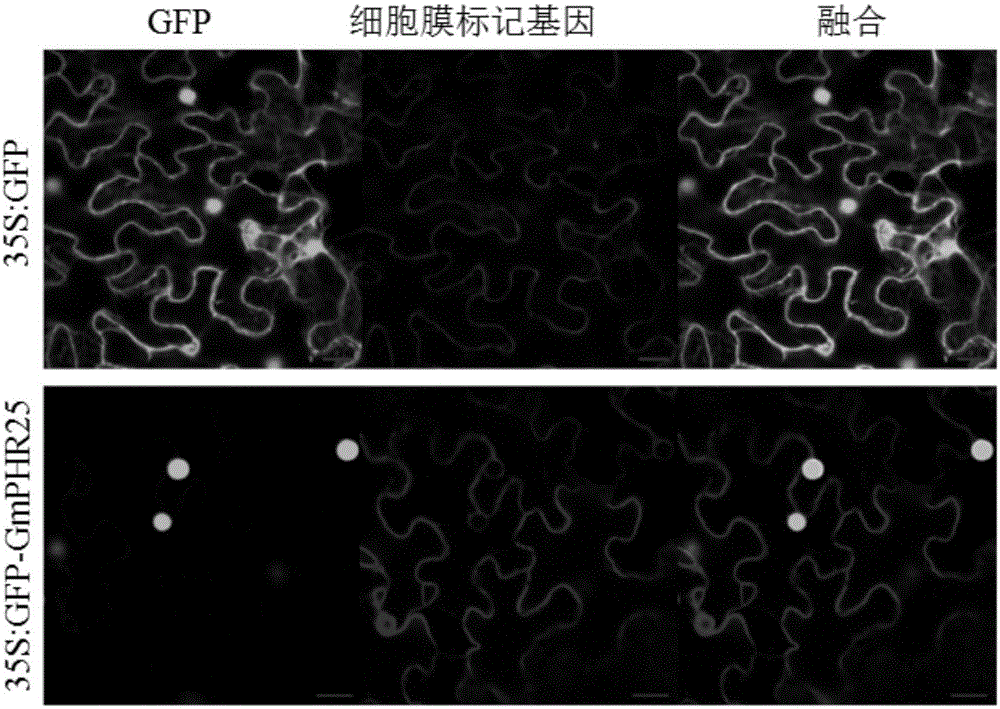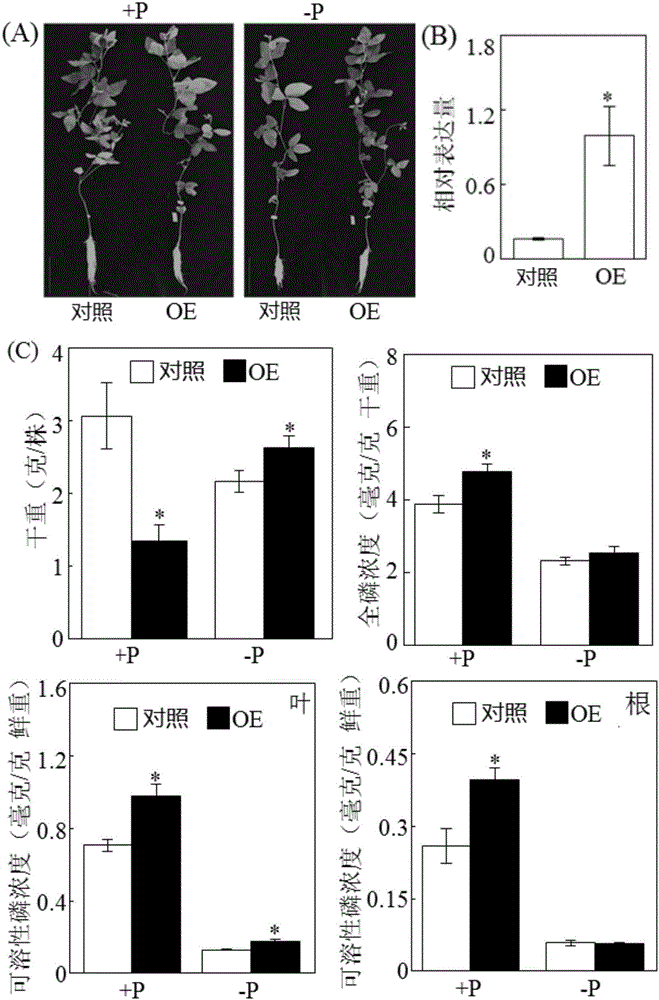Low-phosphorus-resisting key gene GmPHR25 in plant phosphorus signal network and applications of low-phosphorus-resisting key gene GmPHR25
A signaling network, low-phosphorus-resistant technology, applied in the field of plant biology, to achieve the effect of important market prospects
- Summary
- Abstract
- Description
- Claims
- Application Information
AI Technical Summary
Problems solved by technology
Method used
Image
Examples
Embodiment 1
[0049] Example 1 GmPHR25 Gene cloning and vector construction
[0050] 1. Excess (OE -GmPHR25- pYL) expression vector construction
[0051] (1) design GmPHR25 Gene-specific primer OE- GmPHR25 -pYL-F and OE- GmPHR25 -pYL -R:
[0052] Primer OE-GmPHR25-pYL-F (SEQ ID NO.3):
[0053] 5'-GAGCTCATGTATCATTCAAAGAATGTTCCTAG-3'
[0054] Primer OE- GmPHR25 -pYL-R (SEQ ID NO.4):
[0055] 5'-GACGTCTCACAGATTACCGCCACC-3'.
[0056] (2) PCR amplification: the root cDNA of soybean genotype YC03-3 treated with phosphorus deficiency was used as a template, and the gene-specific primer OE- GmPHR25 -pYL-F (SEQ ID NO. 3) and OE- GmPHR25 -pYL-R (SEQ ID NO.4) amplifies GmPHR25Coding region fragment. The PCR reaction system is 50 microliters, including 5 microliters of 10×LaTaq Buffer, 4 microliters of 2.5 mmol / L dNTP, 3 microliters of cDNA template, and 1 microliter of 10 micromol / liter forward and reverse primers , 0.5 microliters of La Taq enzyme, and finally make up to 50 microliters...
Embodiment 2
[0067] Example 2 GmPHR25 Analysis of gene expression patterns and protein subcellular localization
[0068] 1, GmPHR25 Gene expression pattern analysis
[0069] (1) Experimental method
[0070] Select YC03-3 seeds with undamaged seed coat and uniform size, and use 3% hydrogen peroxide (H 2 o 2 ) surface disinfection for one minute, then rinsed twice with deionized water, soaked in 1 / 4 Hoagland nutrient solution for half an hour, and carried out paper culture to accelerate germination. After 5 days, transfer to soybean complete nutrient solution (+P) and phosphorus-deficient nutrient solution (-P). After 14 days of treatment, fully expanded new leaves and root samples were collected, and total RNA was extracted for quantitative PCR analysis.
[0071] Fluorescent quantitative PCR was carried out according to the instructions of the SYBR Green (Promega, USA) quantitative kit, and was run with the Rotor-Gene 3000 qRT-PCR system (Corbett Research, Australia). The cDNA sample...
Embodiment 3
[0085] Example 3 Research on transgenic materials
[0086] 1. Obtaining genetically modified materials
[0087] (1) Obtaining soybean hairy roots in vitro
[0088] Overexpress the constructed OE -GmPHR25- The pYL vector and the empty vector plasmid were transformed into Agrobacterium rhizogenes K599 by freeze-thaw method. Pick positive clones and inoculate them in YEP medium containing corresponding resistance, and culture them at 28°C and 200 rpm for 16 hours. Cut off the radicle of soybeans germinated on MS medium for 4 days with a scalpel dipped in bacteria solution, leaving about 3 mm of hypocotyl and divide it into two from the middle with a scalpel, and then dip the cotyledon and hypocotyl with bacteria solution Gently slit the wound with a scalpel. The cotyledons were placed on moist sterilized filter paper with the incision facing up, and cultured in the light at 25°C for 3 days. The cotyledons were then transferred to hairy root induction medium for culture. Af...
PUM
 Login to View More
Login to View More Abstract
Description
Claims
Application Information
 Login to View More
Login to View More - R&D
- Intellectual Property
- Life Sciences
- Materials
- Tech Scout
- Unparalleled Data Quality
- Higher Quality Content
- 60% Fewer Hallucinations
Browse by: Latest US Patents, China's latest patents, Technical Efficacy Thesaurus, Application Domain, Technology Topic, Popular Technical Reports.
© 2025 PatSnap. All rights reserved.Legal|Privacy policy|Modern Slavery Act Transparency Statement|Sitemap|About US| Contact US: help@patsnap.com



